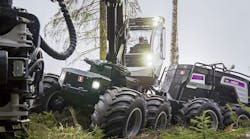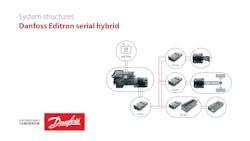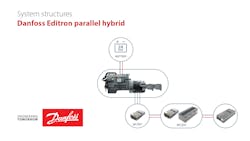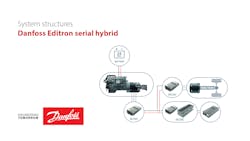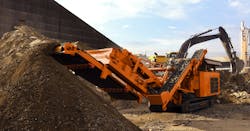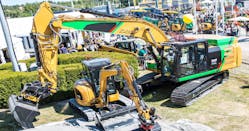As the world aspires to reach net zero, electrification continues to be a focus for all types of applications, especially mobile machinery.
In many off-highway machines, the conventional system architecture is for the internal combustion engine to be the power source, with propulsion achieved through a closed-circuit hydrostatic drive system. Meanwhile, the work, steering and auxiliary functions are typically achieved through at least one open-circuit hydraulic system.
However, high-power electric machines are opening new classes of powertrain architectures in the off-highway industry by acting as the overall or auxiliary prime mover, powering hybrid drivetrains or being the traction motor in a fullyelectric vehicle application. This is enabled by the key characteristics of the electric machines, such as their ability to distribute the prime-mover function more easily and optimally.Other positive qualities include torque curve maximization starting at low speeds, the potential they offer for high conversion efficiency across a wide range of operational modes, and their high controllability. The latter results from a combination of the physical characteristics of electric machines and the control algorithms in the inverter.
In this article the multiple system architectures possible for hybrid and electric vehicles will be explained as well as how to choose the best option for an application.
WATCH MORE: 3 Drivers of Off-Highway Electrification
Parallel Hybrid Systems
This architecture typically retains the original drivetrain design, but adds a motor-generator to the engine crankshaft and energy storage, which enables both the addition and subtraction of electrical power as required. This benefit unlocks peak shaving and the option to either downsize the engine or boost the overall power.
In parallel hybrid systems, periods of electric-only driving can be achieved if a clutch separates the engine and the electric machine. This can help machines start from a standstill or comply with emission-free zones and construction sites.
The overall benefits of a parallel hybrid system architecture are increased productivity, typical fuel savings of between 10-15%, and emissions and noise reduction. They are well suited for applications with high average utilization of power.
One real-world machine Danfoss has delivered with a parallel hybrid system architecture is the Logset 12H GTE forest harvester. During harvesting operations, the parallel hybrid design of this machine enables the engine to operate at a lower, relatively consistent engine speed of approximately 1,700 rpm. This charges a supercapacitor between tree processing before discharging the stored energy to supplement the engine during sawing and stripping operations. This operational profile produces higher productivity and reduces fuel consumption by 20-30%.
Series Hybrid Systems
Similar to the parallel hybrid system, the series hybrid architecture also offers the benefits of peak shaving and power addition, plus the possibility of electric-only operation – as long as the necessary auxiliary functions can be operated independently of the engine. The main difference is that the series hybrid drivetrain replaces the existing drivetrain and must be dimensioned to meet the application's full force and speed requirements.
The benefits of series hybrid systems are similar to parallel hybrid architectures, namely increased productivity and reduced emissions and noise levels. However, the fuel savings are even higher, generally coming in between 20-35%. Danfoss offers series hybrid architectures for applications seeking significant efficiency improvements despite the high average power level and overall energy storage requirements.
The Rockster R1100DE stone crusher is an example of an off-highway machine featuring a series hybrid system. The first-of-its-kind on the market, the machine’s design features an electric powertrain for the crushing system and supercapacitors for cushioning against load peaks. Ultimately, this leads to substantial fuel savings of 16,000 L annually, a productivity improvement of 40%, reduced maintenance, and a relatively short payback period of only 9 months.
Fully Electric Systems
A fully electric system typically powered by a high-voltage battery is the best option for mobile applications requiring exclusively zero-emission operation or maximizing energy efficiency. Danfoss offers several basic variations of fully electric system architectures.
READ MORE: How to Safely Work with High-Voltage Systems
The second generation MinCa 5.1. electric mine vehicle is one example of a fully electric product. This machine can operate for between 3-4 hours before its 50 kWh battery needs to be recharged. The MinCa 5.1. is an excellent example of how emission-free operation can enable significant cost savings through lower fuel and ventilation costs. Other benefits of the machine include reduced noise, vibrations and heat from the vehicle.
For applications requiring the benefits of electric operation but where the ability to modify the machine or meet the capabilities of the existing powertrain is limited, a viable option is to simply swap the engine for an electric prime mover. While there may be more optimal approaches than this in some cases, it can be fast and effective and one of the quickest ways of introducing a battery-electric vehicle to a fleet. Additionally, an electric prime mover is up to 96% efficient, a significant increase compared to a diesel engine, which has an energy conversion efficiency of only around 30%.
This is the method Pon Equipment of Norway chose to achieve a battery-electric excavator in collaboration with Danfoss. Based on a CAT 323F hydraulic excavator, the machine’s engine was replaced with an electric motor, with the vehicle also equipped with a 300 kWh battery. This enables between 5-7 hours of quiet, efficient and emission-free operation, plus supports the Norwegian government’s push for zero-emission construction sites and climate neutrality by 2030.
Which System Architecture Best Suits a Machine
While there is certainly no single correct answer for the entire market, there are many factors to consider when deciding which system architecture best suits an application.
The need for zero-emission operation, the ability to modify base machine design, the capacity to recover energy and access to an energy source are all crucial aspects OEMs should consider. They should also think about whether they wish to maximize productivity or efficiency, prioritize the total cost of ownership, or keep initial costs low and focus on high- or low-utilization duty cycles, as the answers to all of these questions will be crucial in identifying the right system architecture for their application.
With an extensive portfolio of electric machines and power electronics, Danfoss Power Solutions’ Editron division offers products covering various vehicle sizes, sub-system applications, and powertrain architectures (see sidebar below). The company is leveraging years of application knowledge and expertise in hydraulics and mobile machinery to understand and develop these electrified off-highway solutions. By working directly with the OEMs, Danfoss offers support in helping its customers determine the best system architecture for a given application.
This article was written and contributed by Cameron Guernsey, Product Manager at Danfoss’ Editron division and Simon Nielsen, Staff Engineer at Danfoss Power Solutions.
